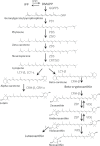Metabolic and gene expression analysis of apple (Malus x domestica) carotenogenesis
- PMID: 22717407
- PMCID: PMC3421989
- DOI: 10.1093/jxb/ers134
Metabolic and gene expression analysis of apple (Malus x domestica) carotenogenesis
Abstract
Carotenoid accumulation confers distinct colouration to plant tissues, with effects on plant response to light and as well as health benefits for consumers of plant products. The carotenoid pathway is controlled by flux of metabolites, rate-limiting enzyme steps, feed-back inhibition, and the strength of sink organelles, the plastids, in the cell. In apple (Malus × domestica Borkh), fruit carotenoid concentrations are low in comparison with those in other fruit species. The apple fruit flesh, in particular, begins development with high amounts of chlorophylls and carotenoids, but in all commercial cultivars a large proportion of this is lost by fruit maturity. To understand the control of carotenoid concentrations in apple fruit, metabolic and gene expression analysis of the carotenoid pathway were measured in genotypes with varying flesh and skin colour. Considerable variation in both carotenoid concentrations and compound profile was observed between tissues and genotypes, with carotenes and xanthophylls being found only in fruit accumulating high carotenoid concentrations. The study identified potential rate-limiting steps in carotenogenesis, which suggested that the expression of ZISO, CRTISO, and LCY-ε, in particular, were significant in predicting final carotenoid accumulation in mature apple fruit.
Figures








References
-
- Alquezar B, Rodrigo MJ, Zacarias L. Regulation of carotenoid biosynthesis during fruit maturation in the red-fleshed orange mutant Cara Cara. Phytochemistry. 2008;69:1997–2007. - PubMed
-
- Bai L, Kim EH, DellaPenna D, Brutnell TP. Novel lycopene epsilon cyclase activities in maize revealed through perturbation of carotenoid biosynthesis. The Plant Journal. 2009;59:588–599. - PubMed
-
- Botella-Pavia P, Besumbes O, Phillips MA, Carretero-Paulet L, Boronat A, Rodriguez-Concepcion M. Regulation of carotenoid biosynthesis in plants: evidence for a key role of hydroxymethylbutenyl diphosphate reductase in controlling the supply of plastidial isoprenoid precursors. The Plant Journal. 2004;40,:188–199. - PubMed
-
- Bramley PM. Regulation of carotenoid formation during tomato fruit ripening and development. Journal of Experimental Botany. 2002;53:2107–2113. - PubMed

